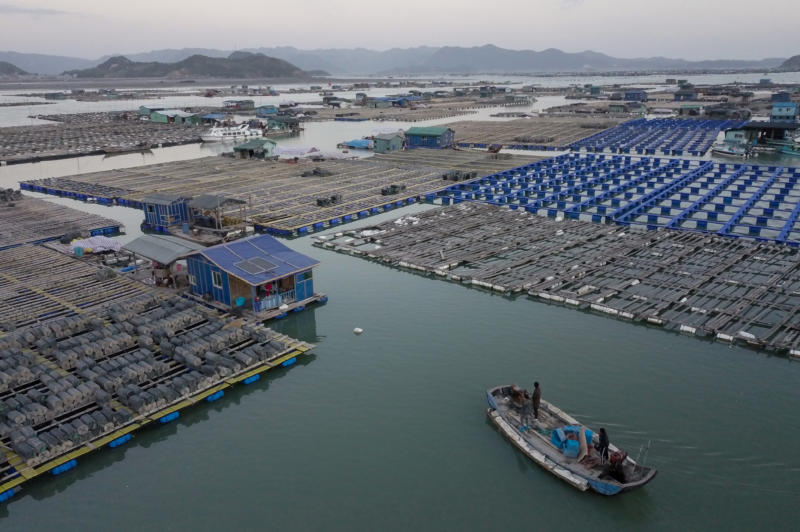China fish farmers harvest troubled waters with floating villages
Xiapu county in China’s Fujian province has become one of the country’s most important aquaculture sites (HECTOR RETAMAL)
Xiapu (China) (AFP) – Fishermen like Zhu Chunfu have hauled their living from the seas off the Chinese province of Fujian for generations, but what happens when over-harvesting causes fish stocks to collapse?
In the case of coastal Xiapu county, you turn to raising the fish yourself, a shift that has made it one of China’s most important aquaculture sites and spawned communities floating at sea.
The water in this area of maze-like bays and coves is covered by a patchwork of hundreds of floating platforms where fishermen live and tend to underwater expanses of nets and cages teeming with sea cucumbers, yellow croakers, seaweed and other marine produce.
“My ancestors were fishing in the sea ages ago, and when there were not enough fish to catch, we started to make a living by aquaculture,” Zhu said, standing next to a small hut where he lives for several months of the year with seven others.
Beneath him, swaying in the gentle waves, hang dozens of underwater cages full of sea cucumbers, a squishy, elongated cousin of the starfish that is popular in Chinese cuisine and traditional medicine.
Zhu, who has lived at sea most of his life, says sea cucumber breeders like himself can earn hundreds of thousands of yuan per year.
Aquaculture took off in the area in the late 1980s, fuelled in part by the decades-long collapse of yellow croaker stocks.
– Troubled waters –
Formerly abundant in China’s waters, the species’ popularity on the Chinese dinner table saw it overharvested to the point that wild stocks are no longer commercially viable.
Today, aquaculture has made China by far the world’s largest producer of yellow croaker, with Fujian in the country’s southeast accounting for more than 85 percent of national output, according to the UN Food and Agriculture Organization.
Xiapu county is the beating heart of that production, and as a result, communities like the floating village of Dongan have sprung up, including wooden houses complete with kitchens and toilets.
As with everywhere in China, the county was brought to a standstill by the coronavirus epidemic, which essentially shut down the national economy.
But at the urging of the area’s government, its fishery business was among the first to get back up and running to take advantage of the harvest season, according to local media reports.
Work began to resume in February — with the requisite checkpoints set up for taking the temperatures of workers and fish farmers — and the busy spring harvesting season is now in full swing.
Boats hawking supplies wind their way through the farms, and even simple restaurants and hotel lodgings are available.
Locals estimate that up to 20,000 people spend all or part of their time out on Xiapu’s waters, though it remains to be seen how the coronavirus epidemic will affect that.
Xiapu’s way of life is also under threat from pollution.
Blocks of buoyant hard foam underpin the platforms, and fragments of the non-biodegradable material litter the waters, as does waste from the floating communities: sewage is released directly into the ocean and pollutants from fish feed foul the water.
An influx of poorer migrants from China’s interior, drawn by aquaculture’s economic opportunities, have amplified the harmful impacts.
In 2018, the local government established new rules to rein in pollution and control the rapid expansion of the farms.
“Authorities are tackling the problem at the source but it’s too soon to tell the effect,” said Guo Shigui, 33, who farmed fish at sea for six years until moving to land two years ago to pursue an e-commerce career.
He still speaks fondly of his time on the water.
“I was like a bird in a cage, with limited space to move around,” Guo said.
“But I also felt free.”
Disclaimer: Validity of the above story is for 7 Days from original date of publishing. Source: AFP.


